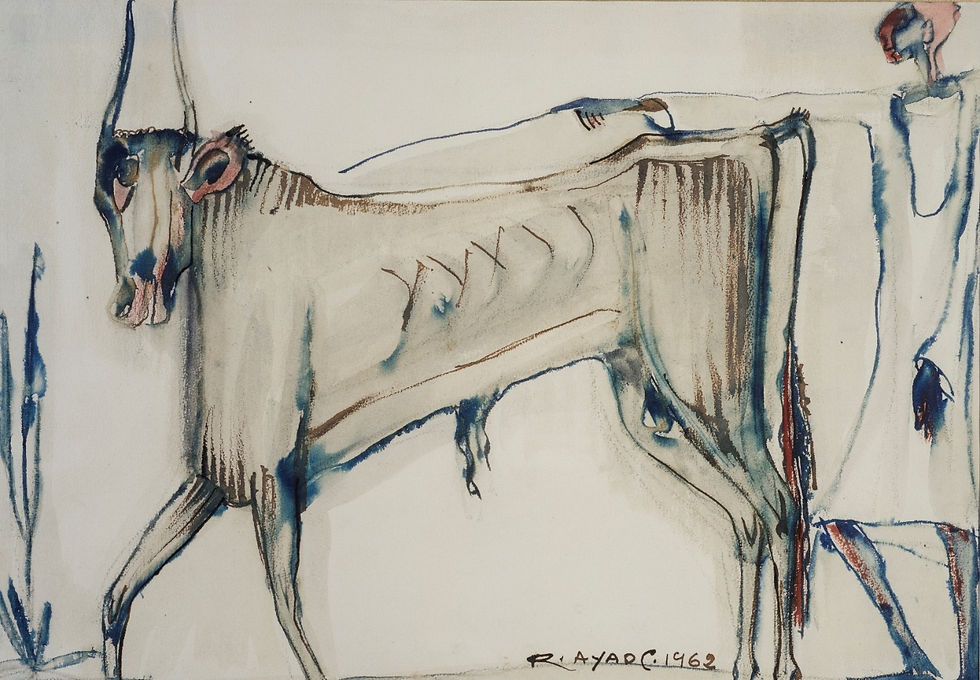Egyptian pioneer artists: Ragheb Ayad
- julia_mji@me.com
- May 18, 2021
- 3 min read
Updated: Sep 16, 2025
Egyptian pioneer artists: Ragheb Ayad
Ragheb Ayad is one of the leading painters of a generation of Egyptian artists commonly referred to as the pioneers (ar-ruwwād ), as they were the first to be educated in artistic institutions established according to European models, such as the School of Fine Arts in Cairo.
Ragheb Ayad was born in Cairo on the 10th of March 1892 and inscribed himself in the School of Fine Arts since its opening in 1908. After graduation, he taught art in the high Coptic school and made several trips on his own to France and Italy to complete his artistic education. He was the first to obtain a governmental scholarship to Rome where he stayed for five years studying art in the Superior Institute of Fine Arts. Since his return to Cairo in 1930, he was assigned as director of the decorative section of the Faculty of Applied Arts. In 1937, he is named professor at the Faculty of Fine Arts and director of its free section. He was in charge of reorganizing the Coptic museum and since 1950 became head of the Museum of Modern Art where he made a special section in it for the great sculpture Mahmoud Mokhtar. Since 1924 and for half a century he participated in most of the exhibitions of the ‘Cairo Salon’ plus organizing 40 solo exhibitions. Ragheb Ayad is considered one of the pioneers of Egyptian art in the 20th century alongside Mahmoud Mokhtar, Youssef Kamel, Mohamed Hassan, Mahmoud Said, and Mohamed Naghy.
Ragheb Ayad is the first to get rid of western influences and to create Egyptian art with its own solid identity. For the rest of his life, Ragheb Ayad was dedicated to the popular themes of Egyptian life whether it is the cosmopolitan Cairo or the upper Egyptian villages and the small towns. He visited all these places recording the pulsating life of the soaks, the moulids, the cafes, and the men and women dancers. Ragheb Ayad remained forever the painter of this true Egyptian universe. Ragheb Ayad is considered to be the first expressionistic painter who influenced the second and third generation of artists. Aside from the popular Ayad was attracted to the religious themes where he portrayed the flight of the holly family in Egypt and the birth of Jesus. Moreover, Ayad is known to be the first Egyptian artist to be influenced by ancient Egyptian art, and this quite relevant in his paintings dealing with rural life. In them, we see the succession of different aspects of the rural life being portrayed vertically on horizontal layers instead of the perspective view.
Ayad mastered the art of sketching and besides his oil paintings, he produced numerous sketches and drawings enhanced with watercolors such as gouache. His expressive style is characterized by the vivacity of his textured strokes that express the dynamic of constant movement, as well as by the use of powerful colors. His work is profoundly marked by the arts of Ancient Egypt: the formal aesthetic of the decorative bas-reliefs and paintings of the tombs and temples of Thebes inspired him to reinvent the ancient system of superposed narrative scenes, which sometimes led him to use horizontal formats.
Towards the end of his career, his style progressively evolved towards the purification of lines and stylization of forms.
Ayad was also a skilled decorator and painted several interiors of public and private buildings. In 1935, he executed a series of decorative paintings for the old Shepherd Hotel that was unfortunately destroyed in the Cairo fire in 1952. He also participated in the interior decoration of religious buildings such as the Coptic Cathedral of Sohag and the Catholic Churches of Minia and Samalut.
During his lifetime, he held numerous solo and collective exhibitions in Egypt and abroad. His works are exposed at the Museum of Egyptian Modern Art, the Agricultural Museum in Cairo, the Museum of Fine Arts in Alexandria, and at Mathaf: Arab Museum of Modern Art in Doha.
He died in Cairo in 1982.
View Ragheb Ayad's work on ARTSY
Request catalogue: info@jmartmanagement.com
* Presented by JM Art Management in collaboration with Safarkhan gallery.
JM Art Management








